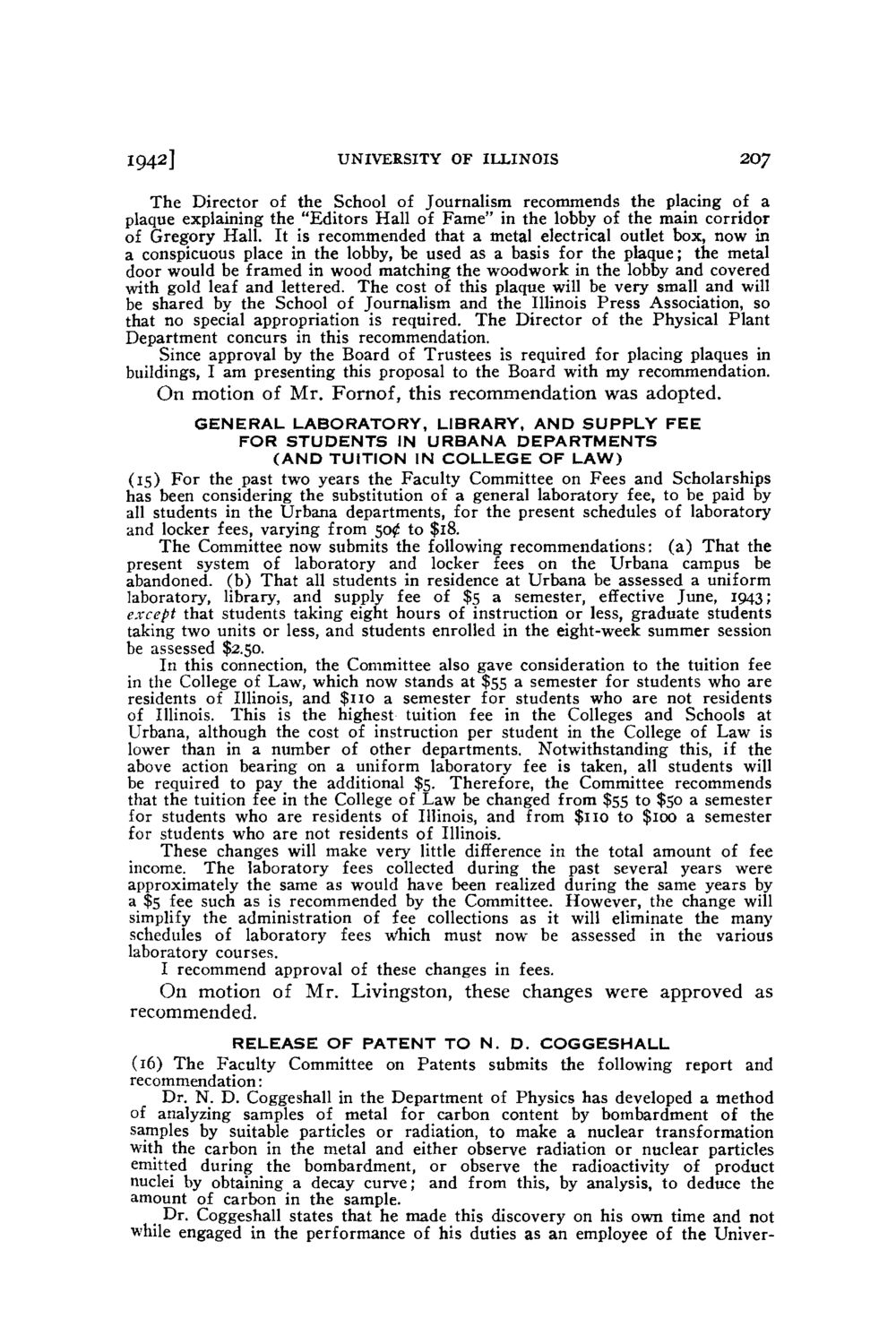| |
| |
Caption: Board of Trustees Minutes - 1944
This is a reduced-resolution page image for fast online browsing.

EXTRACTED TEXT FROM PAGE:
1942] UNIVERSITY OF ILLINOIS 207 T h e Director of the School of Journalism recommends the placing of a plaque explaining the "Editors Hall of Fame" in the lobby of the main corridor of Gregory Hall. It is recommended that a metal electrical outlet box, now in a conspicuous place in the lobby, be used as a basis for the plaque; the metal door would be framed in wood matching the woodwork in the lobby and covered with gold leaf and lettered. The cost of this plaque will be very small and will be shared by the School of Journalism and the Illinois Press Association, so that no special appropriation is required. T h e Director of the Physical Plant Department concurs in this recommendation. Since approval by the Board of Trustees is required for placing plaques in buildings, I am presenting this proposal to the Board with my recommendation. O n m o t i o n of M r . F o r n o f , t h i s r e c o m m e n d a t i o n w a s a d o p t e d . GENERAL LABORATORY, LIBRARY, AND SUPPLY FEE FOR STUDENTS IN URBANA DEPARTMENTS ( A N D TUITION IN COLLEGE OF L A W ) (15) F o r the past two years the Faculty Committee on Fees and Scholarships has been considering the substitution of a general laboratory fee, to be paid by all students in the Urbana departments, for the present schedules of laboratory and locker fees, varying from 50^ to $18. T h e Committee now submits the following recommendations: (a) That the present system of laboratory and locker fees on the Urbana campus be abandoned, (b) That all students in residence at Urbana be assessed a uniform laboratory, library, and supply fee of $5 a semester, effective June, 1943; except that students taking eight hours of instruction or less, graduate students taking two units or less, and students enrolled in the eight-week summer session be assessed $2.50. In this connection, the Committee also gave consideration to the tuition fee in the College of Law, which now stands at $55 a semester for students who are residents of Illinois, and $110 a semester for students who are not residents of Illinois. This is the highest tuition fee in the Colleges and Schools at Urbana, although the cost of instruction per student in the College of Law is lower than in a number of other departments. Notwithstanding this, if the above action bearing on a uniform laboratory fee is taken, all students will be required to pay the additional $5. Therefore, the Committee recommends that the tuition fee in the College of Law be changed from $55 to $50 a semester for students who are residents of Illinois, and from $110 to $100 a semester for students who are not residents of Illinois. These changes will make very little difference in the total amount of fee income. The laboratory fees collected during the past several years were approximately the same as would have been realized during the same years by a $5 fee such as is recommended by the Committee. However, the change will simplify the administration of fee collections as it will eliminate the many schedules of laboratory fees which must now be assessed in the various laboratory courses. I recommend approval of these changes in fees. O n m o t i o n of M r . L i v i n g s t o n , t h e s e c h a n g e s w e r e a p p r o v e d a s recommended. RELEASE OF PATENT TO N. D. COGGESHALL (16) The Faculty Committee on Patents submits the following report and recommendation: Dr. N. D. Coggeshall in the Department of Physics has developed a method of analyzing samples of metal for carbon content by bombardment of the samples by suitable particles or radiation, to make a nuclear transformation with the carbon in the metal and either observe radiation or nuclear particles emitted during the bombardment, or observe the radioactivity of product nuclei by obtaining a decay curve; and from this, by analysis, to deduce the amount of carbon in the sample. Dr. Coggeshall states that he made this discovery on his own time and not while engaged in the performance of his duties as an employee of the Univer-
| |